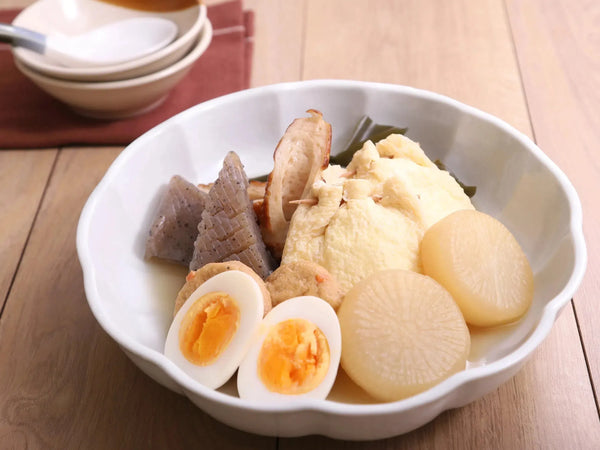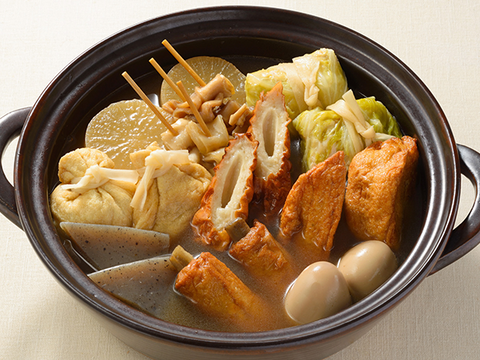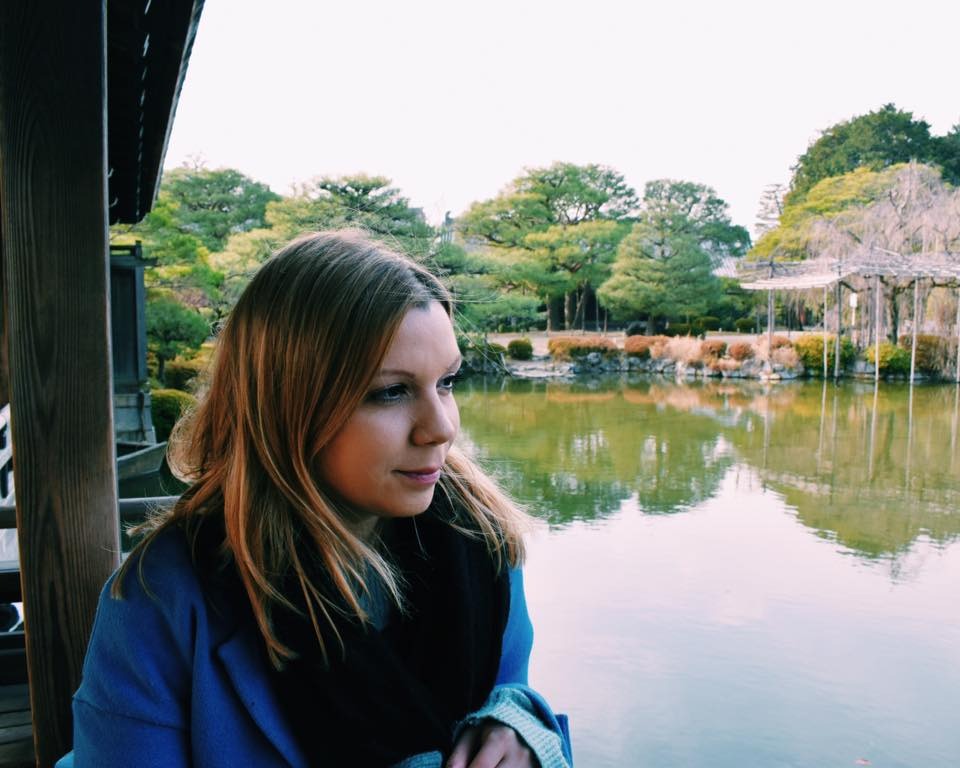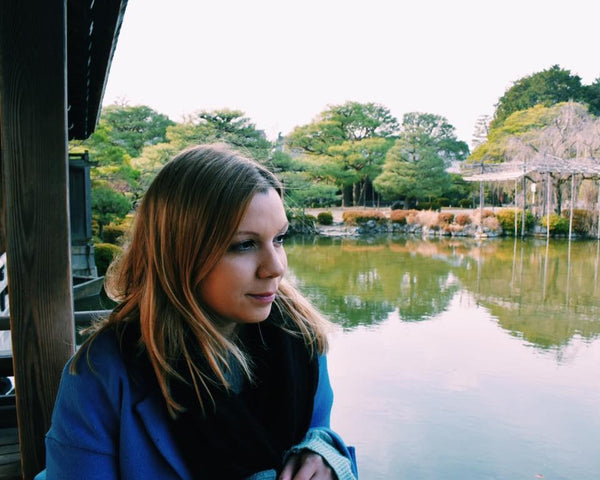
Jump to:
If you’re looking for a Japanese winter meal to try making at home, then oden is the perfect dish to prepare and can be made in a large batch to last for several days. If you’ve ever visited Japan during the wintertime, you may have seen oden simmering away at the counter in convenience stores.
In this article we’ll take a closer look at everything you need to know about oden including its origins, regional variations, typical ingredients, how to eat it, and where to purchase oden ingredients!
A Brief History of Oden

Oden originated from a dish called ‘tofu dengaku’ which was popular during Japan’s Muromachi period (1336-1573). Tofu dengaku is a grilled piece of firm tofu skewered onto a bamboo stick and smothered in miso. Over time the word ‘dengaku’ gradually became known as ‘oden’.
Later, during Japan’s Edo period (1603-1868), the concept of oden spread among the common people, and other ingredients such as konnyaku or konjac (yam cake), vegetables, and fish were gradually added into the oden category too. For the impatient Edo people who could not wait for the oden ingredients to be grilled one by one, oden changed from being a grilled dish to a simmered dish where ingredients could be prepared in large batches all in one go. People enjoyed oden as a fast food.
In the Meiji period (1868-1912), oden became more like the soup that is commonly served today. It spread throughout Japan and each region adapted the dish to develop their own unique taste preferences.
In the Showa era (1926-1989), oden became more widely available at places such as izakaya (Japanese style pubs), food stalls, and convenience stores. When oden can be found simmering away at convenience store counters, Japanese people feel that the winter season has arrived. The ritual of eating hot oden by blowing on it to cool it is a winter tradition for Japanese people.
Oden Regional Specialties

Throughout Japan you can find many regional variations of oden, but there are some common ingredients among all the dishes. Items such as tofu, daikon, konjac, and eggs can usually be found in oden, but depending on the region, the flavor of the soup and other ingredients can vary greatly. Below are four of the most common types:
Tokyo style oden

This old-fashioned oden contains rich soy sauce and dried bonito flakes as the base of the soup. The soup is dark brown in color and has a strong taste. Typical ingredients include nerimono such as chikuwa (white fish paste) and hanpen (fishcake) which is made by grinding and heating the fish.
Nagoya style oden

What makes this variation of oden unique is the soup. The soup in Nagoya-style oden is very thick in texture and is made from hatcho miso (a type of miso traditionally made from 100% soybeans), sanonto sugar (a light brown sugar ideal for cooking), and sake, making it quite rich in flavor.
It almost looks black in color because of the dark hatcho miso which is local to the area. This Nagoya-style oden tastes sweet and spicy and typical ingredients are pork maw (stomach), beef sinew, radish, and baked tofu.
Kyoto style oden

The soup in Kyoto-style oden is simply seasoned with kombu (kelp), bonito flakes, light soy sauce, and salt. It is transparent and light in color. Typical ingredients include fried tofu, ganmodoki (fried tofu fritter made with vegetables), and yuba (dried tofu skin). Also, satoimo, a root vegetable also known as Japanese taro, is often included in Kyoto style oden.
Fukuoka style oden

The soup in Fukuoka-style oden is a combination of bonito flakes, kombu, and rich soy sauce. Typical ingredients are cabbage rolls and dumplings which are found only in this region and make the soup richer in flavor.
What Is Typically Included in Oden?
Maybe you want to make Oden at home, but you're wondering which ingredients are necessary or often included. In Japan, each family has their own variation of oden depending on the region and preferences, but let’s look at some common ingredients that can be found in oden.
Daikon

Daikon is a kind of Japanese radish used in many Japanese dishes and is especially popular in oden. It’s a long and white crunchy vegetable similar in appearance to horseradish. In oden it’s usually cut into thick slices, and when daikon is simmered well it absorbs the flavor of the soup well and becomes sweet in taste. It also becomes so soft that you can cut it using chopsticks alone.
Konjac

Konjac is a kind of processed food made from starch from the konjac taro plant. It has been a popular ingredient in Japanese cuisine for a long time and can be found in all kinds of dishes but is particularly common in hotpot dishes and stews. Konjac is high in fiber and very low in calories. It has a chewy texture and is flavorless. In recent years it has become a popular diet food in western countries!
Eggs
Hard boiled eggs are also a popular ingredient in oden because they soak up the flavor of the soup and are easy to eat. You can use chicken or quail eggs.
Satoimo

This is more local to the Kyoto style of oden, but satoimo is a root vegetable also known as Japanese taro. When raw it has a very tough texture, but it becomes very soft and sticky when it’s cooked. Satoimo is often used in home-cooked Japanese dishes and is usually simmered in dashi and soy sauce.
Atsuage

This deep-fried tofu is inexpensive and a great source of protein. You can find atsuage in many Japanese dishes as it is a popular ingredient for simmered dishes, stir fries, and miso soup as well as oden. It absorbs a lot of soup stock, so that when you eat it, the soup stock fills your mouth. It's really delicious!
Ganmodoki

These are deep-fried tofu fritters made with vegetables such as carrots, burdock root, shiitake mushrooms, and kikurage mushrooms. They can also contain other ingredients such as seaweed, spring onions, and edamame beans.
Chikuwa

This fish cake is made from fish paste and has been seasoned and cooked. It is made from white fish such as pollock or bass and is often used as an ingredient in simmered dishes, udon, and yakisoba. When it’s cooked in oden, it expands with the soup stock, filling your stomach. First the ingredients are wrapped around a bamboo or metal stick then steamed or broiled.
Goboten

Goboten is burdock wrapped in fish paste which has been deep fried. It’s also a popular ingredient in dishes in the Fukuoka region where you can find it served with udon noodles.
Mochi

Especially popular in Kyoto style oden, small pieces of mochi (rice cake) are wrapped into deep-fried tofu pockets.
Soup

As previously mentioned, the soup base depends on the region. In our recipe, we made Kyoto oden so our soup base consisted of kombu (kelp), bonito flakes, light soy sauce, and salt. The amount of ingredients in the seasoning varies and can be adjusted according to your preferred tastes. It can be a little difficult to find the exact right flavor so it’s good to keep tasting the soup and adjusting the seasoning until it meets your preferences.
If you want to learn more about making oden at home, then check out our separate oden recipe!
How to Eat Oden
Since oden is made with many ingredients, take your favorite ingredients from the large pot and cut them into small pieces with chopsticks and eat with the soup stock. If you like, you can add spices such as Japanese mustard or shichimi pepper.
When Japanese make oden at home, it’s usually in a large batch, so it can be eaten the next day too. If you still have some leftovers, you can make a Japanese style curry by adding curry roux for a different taste.
Western-Style Oden Ingredients

If you do not have access to many Japanese ingredients, you can also make a western oden-inspired dish. Below is a list of some western-style ones in case you have trouble getting hold of anything outside of Japan and want to substitute some items:
- Boiled eggs
- Firm tofu
- Asparagus
- Potato
- Carrots
- Green beans
- Mushrooms
- Chicken meatballs
- Bacon or ham
- Rolled cabbage
- Fish cake
- Onions
- Hot dog sausages
Where can I buy oden ingredients?

You can find many of the fresh ingredients you need such as vegetables in your local Asian supermarket, or if you are making a western-style oden then your local grocery store will carry most of the products you’ll need. If you live near a Japanese or Asian grocery store, you may even be able to find a special kit for making oden that comes with most of the necessary ingredients like the fish cakes and tofu.
You can order some of the other essential items you’ll need to make oden through the Japanese Taste website:
Shiro Dashi Soup Base
One of the most important ingredients you’ll need to make oden is the shiro dashi soup base. Yamaki Kappo Shiro Dashi is a concentrated soup base made with bonito flakes that adds aroma, saltiness, and umami to any dish without changing the original food’s color or ingredients. This shiro dashi stock concentrate contains only carefully chosen quality katsuoboshi (dried bonito flakes) and is a staple cooking ingredient for any aspiring chefs of Japanese cuisine.
Condiments
It’s common to eat oden with Japanese mustard or shichimi pepper. S&B Karashi Sauce Japanese Mustard Paste is a blend of Japanese and Western mustards. This enhances the umami flavor and offers a rich aroma and faint bitterness accompanied by a smooth texture. Japanese mustard is an excellent accompaniment to oden because it refreshes and lightens the taste.
This Shichimi Togarashi from House Foods, also known as Japanese 7 Spice, is a common seasoning in Japan made from carefully selected spices and goes particularly well with oden. The Japanese spice mix from House contains seven curated oriental spices and is completely natural.
Eating a hot bowl of oden on a cold day warms your body from the inside, so if you have time, please give it a try!


0 comments